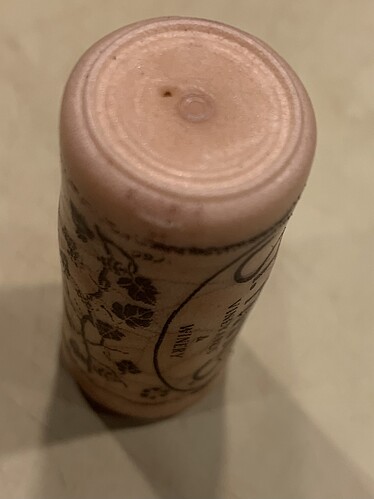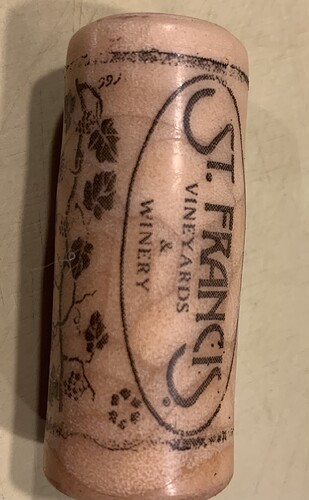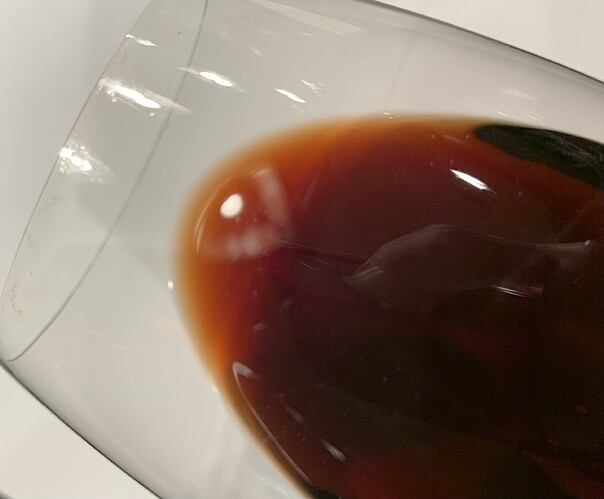There was a period of time when “plastic” corks (I don’t know if these are technically, chemically considered truly plastic, but I am using the term here) were thought perhaps to be a better mousetrap, durable and not subject to degradation with time, certainly not a cause of corked wine.
If my understanding is correct, this proved to be mostly erroneous. For example, @RandallG very publicly lamented his use of these cork substitutes, as they turned out to result in a high rate of oxidized wines.
Anyway, the reason I made this post…
Purchased this 1997 St. Francis Reserve Merlot from an auction site. A bit of a curiosity, but got a good price on it, and it had some solid ratings.
Removed the capsule, and, uh oh, I spy one of these synthetic corks.
There are no markings on the cork to indicate a specific manufacturer.
Long story short, there doesn’t seem to be any problem at all in this case. No signs of oxidation (a bit of bricking, consistent with the wine’s age), Lovely plum, cedar, spice box components. Extremely happy with this one.
So, I’m wondering, does anyone here have more broad experience with these “fake corks,“ how they stand up over time? Did I get lucky, or are these really not necessarily so bad?
St. Francis used Supreme Corq at that time. I drank a lot of their Zins from the 1992 to 1997 vintage and really enjoyed them, but didn’t age any. Glad your Merlot held up.
Edited: The biggest issue I recall with Supreme Corqs was getting them off the corkscrew. They could strip the Teflon off a coated screw.
We experimented with using synthetic corks before we started producing wines commercially. After only two to three years in bottle, a disproportionate percentage of bottles were oxidized. This was in the late-90’s. I am sure technology has improved, but at the time we weren’t impressed and wouldn’t take a chance that our commercial wines would be compromised. Also there wasn’t any noticeable savings vs.cork. Glad you had a good bottle.
I would say you lucked out, Nate. The problem w/ the Supremcorq is that they lacked resilience and allowed air to ingress. I had lots of Garretson & Caffaro wines that went South.
Plus they were a bitch to get the removed Corq off the corkscrew. Don’t know how many times I slashed my finger open.
Tom
You got really lucky.
As an alternative closure, plastic corks never had any advantages over screwcaps, and some obvious detriments. That said, I, too, had better results from them in the cellar than anticipated. (I tried to avoid cellaring them, but some slipped through.)
The newer alternative corks can be excellent, including Nomacorc, which is all resin. (The other one we deal with a lot is Diam, which is cork granules held together with resin.)
How are those plastic corks that Ponsot and Frank Cornelissen use?
Do they hold up in the cellar?
I worked at St. Francis during that era and I knew then as a kid that plastic cork was a bad idea. They stopped using them shortly after the 1999’s I believe. Every one of those bottles that I have opened in the past 4-5 years has oxidized faster than they should especially being those wines (Pagani Zin, Pagani Alicante Bouchet, McCoy Cabernet Franc, Reserve Merlot, Kings Ridge Cab, etc.) were monster fruit and tannin bombs that were black as night and in theory should have aged a long time. All American Oak too.
That bottle was incredibly delicious back when. From a small little vineyard called Behler Vineyard and was their crown jewel for a long time. Ironically Sally Johnson was an assistant there at the time, Sarah Wuethrich and Katie Madigan worked in the lab and are all now rockstar women winemakers. That label brings back the feels ![]()



